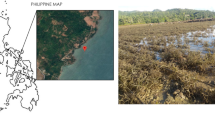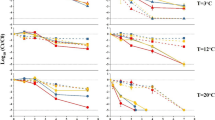Abstract
Irrigation ponds may act as a source of phytopathogenic species that might infest crops through the irrigation systems. Many studies have shown that submerged macrophytes can improve water clarity by out-competing phytoplankton by means of various mechanisms: favoured phytoplankton-grazing zooplankton, reduced nutrient and light availability, increased sinking losses and the release of allelopathically active substances. However, less information is available on the effects of submerged macrophytes on heterotrophic aquatic organisms such as pathogenic bacteria, fungi or oomycete species. This paper studies the effects of three submerged macrophytes—Chara fragilis, Potamogeton pectinatus and Najas marina—on the viability in water of propagules of two phytopathogenic isolates of the oomycetes Pythium aphanidermatum and Pythium ultimum. Moreover, we tested general antimicrobial properties (against bacteria and fungi in water) for these macrophytes. The results showed clear inhibitory effects of all three macrophytes on bacterial density in water and of C. fragilis on the viability of Pythium. Thus, preserving aquatic vegetation in irrigation ponds (i.e. charophytes), besides its purely environmental interest, may have important agronomic benefits owing to their role as biological control against some phytopathogenic agents.




Similar content being viewed by others
References
Andrews, J. H. & R. F. Harris, 2000. The ecology and biogeography of microorganisms on plant surfaces. Annual Review of Phytopathology 38: 145–180.
Anthoni, U., P. H. Nielsen, L. Smithhansen, S. Wium-Andersen & C. Christophersen, 1987. Charamin, a quaternary ammonium ion antibiotic from the green-alga Chara globularis. Journal of Organic Chemistry 52: 694–695.
Aota, Y. & H. Nakajima, 2001. Mutualistic relationships between phytoplankton and bacteria caused by carbon excretion from phytoplankton. Ecological Research 16: 289–299.
APHA, 2005. Standard Methods for the Examination of Water and Wastewater, 22nd ed. American Public Health Association, Washington, DC.
Ballesteros, E., D. Martin & M. J. Uriz, 1992. Biological activity of extracts from some Mediterranean macrophytes. Botanica Marina 35: 481–485.
Bankova, V., K. Stefanov, S. Dimitrova-Konaklieva, G. Keremedchieva, X. Frette, C. Nikolova, A. Kujumgiev & S. Popov, 2001. Secondary metabolites and lipids in Chara globularis Thuill. Hydrobiologia 457: 199–203.
Barnes, G. T., 2008. The potential for monolayers to reduce the evaporation of water from large water storages. Agricultural Water Management 95: 339–353.
Bloem, E., S. Haneklaus & E. Schnug, 2005. Significance of sulphur compounds in the protection of plants against pests and diseases. Journal of Plant Nutrition 28: 763–784.
Bloem, E., S. Haneklaus, I. Salac, P. Wickenhauser & E. Schnug, 2007. Facts and fiction about sulfur metabolism in relation to plant-pathogen interactions. Plant Biology 9: 596–607.
Bolser, R. C., M. E. Hay, N. Lindquist, W. Fenecal & D. Wilson, 1998. Chemical defenses in freshwater macrophytes against crayfish herbivory. Journal of Chemical Ecology 24: 1639–1658.
Bonachela, S., M. Juan, J. J. Casas, F. Fuentes-Rodríguez, I. Gallego & M. A. Elorrieta, 2013. Pond management and water quality for drip irrigation in Mediterranean intensive horticultural systems. Irrigation Science 31: 769–780.
Borkow, G. & J. Gabbay, 2005. Copper as a biocidal tool. Current Medical Chemistry 12: 2163–2175.
Brix, H., 1997. Do macrophytes play a role in constructed treatment wetlands? Water Science and Technology 35: 11–17.
Bushmann, P. J. & M. S. Ailstock, 2006. Antibacterial compounds in estuarine submersed aquatic plants. Journal of Experimental Marine Biology and Ecology 331: 41–50.
Casas, J. J., J. Toja, S. Bonachela, F. Fuentes, I. Gallego, M. Juan, D. León, P. Peñalver, C. Pérez & P. Sánchez, 2011. Artificial ponds in a Mediterranean region (Andalusia, southern Spain): agricultural and environmental issues. Water and Environment Journal 25: 308–317.
Chrzanowski, T. H. & J. P. Grover, 2001. Effects of mineral nutrients on the growth of bacterio- and phytoplankton in two southern reservoirs. Limnology and Oceanography 46: 1319–1330.
Chu, S. P., 1942. The influence of the mineral composition of the medium on the growth of planktonic algae. Part I. Methods and culture media. Journal of Ecology 30: 284–325.
Cole, J. J., S. Findlay & M. L. Pace, 1988. Bacterial production in fresh and saltwater ecosystems: a cross-system overview. Marine Ecology-Progress Series 43: 1–10.
Cook, C. D. K., 1990. Aquatic Plant Book. SPB Academic Publishing, The Hague, The Netherlands.
Costerton, J. W., Z. Lewandowski, D. E. Caldwell, D. R. Korber & H. M. Lappin-Scott, 1995. Microbial biofilms. Annual Review of Microbiology 49: 711–745.
Cyr, H. & M. L. Pace, 1993. Magnitude and patterns of herbivory in aquatic and terrestrial ecosystems. Nature 361: 148–150.
Czeczuga, B., A. Godlewska, B. Kiziewicz, E. Muszynska & B. Mazalska, 2005. Effect of aquatic plants on the abundance of aquatic zoosporic fungus species. Polish Journal of Environmental Studies 14: 149–158.
De Cook, A. W. A. M., C. A. Lévesque, J. M. Melero-Vara, Y. Serrano, M. L. Guirado & J. Gómez, 2008. Pythium solare sp. nov., a new pathogen of green beans in Spain. Mycological Research 112: 1115–1121.
Elmer, W. H., 2008. Preventing spread of Fusarium wilt of Hiemalis begonias in the greenhouse. Crop Protection 27: 1078–1083.
Fareed, M. F., A. M. Haroon & S. A. Rabeh, 2008. Antimicrobial activity of some macrophytes from Lake Manzalah (Egypt). Pakistan Journal of Biological Sciences 11: 2454–2463.
Fuentes-Rodríguez, F., M. Juan, I. Gallego, M. Lusi, E. Fenoy, D. León, P. Peñalver, J. Toja & J. J. Casas, 2013. Diversity in Mediterranean farm ponds: trade-offs and synergies between irrigation modernization and biodiversity conservation. Freshwater Biology 58: 63–78.
Ghazala, B., B. Naila, M. Shameel, S. Shahzad & S. M. Leghari, 2004. Phycochemistry and bioactivity of two stonewort algae (Charophyta) of Sindh. Pakistan Journal of Botany 36: 733–743.
Gill, D. L., 1970. Pathogenic Pythium from irrigation ponds. Plant Disease Report 54: 1077–1079.
Greenway, M., 2005. The role of constructed wetlands in secondary effluent treatment and water reuse in subtropical and arid Australia. Ecological Engineering 25: 501–509.
Gross, E. M., 1999. Allelopathy in benthic and littoral areas: case studies on allelochemicals from benthic cyanobacteria and submersed macrophytes. In Inderjit, K. M. M. & C. L. Foy (eds), Principles and Practices in Plant Ecology: Allelochemical Interactions. CRC Press, Boca Raton: 179–199.
Harvell, C. D., C. E. Mitchell, J. R. Ward, S. Altizer, A. P. Dobson, R. S. Ostfeld & M. D. Samuel, 2002. Climate warming and disease risks for terrestrial and marine biota. Science 296: 2158–2162.
Hilt, S. & E. M. Gross, 2008. Can allelopathically active submerged macrophytes stabilize clear-water states in shallow lakes? Basic and Applied Ecology 9: 422–432.
Hong, C. & G. Moorman, 2005. Plant pathogens in irrigation water: challenges and opportunities. Critical Reviews in Plant Sciences 24: 189–208.
Huss, A. A. & J. D. Wehr, 2004. Strong indirect effects of a submersed aquatic macrophyte, Vallisneria americana, on bacterioplankton densities in a mesotrophic lake. Microbial Ecology 47: 305–315.
Juan, M., J. J. Casas, S. Bonachela, F. Fuentes-Rodríguez, I. Gallego & M. A. Elorrieta, 2012. Construction characteristics and management practices of in-farm irrigation ponds in intensive agricultural systems. Agronomic and environmental implications. Irrigation and Drainage 61: 657–665.
Juan, M., J. J. Casas, S. Bonachela, I. Gallego, F. Fuentes-Rodríguez, E. Fenoy & M. A. Elorrieta, 2013. Management effects on fungal assemblages in irrigation ponds: are biodiversity conservation and the control of phytopathogens compatible? Fundamental and Applied Limnology 183: 259–270.
Kannwischer, M. E. & D. J. Mitchell, 1978. The influence of a fungicide on the epidemiology of black shank of tobacco. Phytopathology 68: 1760–1765.
King, E. O., M. K. Ward & D. E. Raney, 1954. Two simple media for the demonstration of pyocyanin and fluorescein. Journal of Laboratory and Clinical Medicine 44: 301–307.
Krischik, V. A., R. W. Goth & P. Barbosa, 1991. Generalized plant defense: effects on multiple species. Oecologia 85: 562–571.
Krom, M. D., 1980. Spectrophotometric determination of ammonia: a study of a modified Berthelot reduction using salicylate and dichloroisocyanurate. The Analyst 105: 305–316.
Martínez-Álvarez, V., A. Baille, J. M. Molina-Martínez & M. M. González-Real, 2006. Efficiency of shading materials in reducing evaporation from free water surfaces. Agricultural Water Management 84: 229–239.
Martyn, R. D. & Y. S. Cody, 1983. Isolation of phenol cells from waterhyacinth leaves and possible effects on the growth of foliar pathogens. Journal of Aquatic Plant Management 21: 58–62.
Monteiro, M. I. C., F. N. Ferreira, N. M. M. De Oliveira & A. K. Ávila, 2003. Simplified version of the sodium salicylate method for analysis of nitrate in drinking waters. Analytica Chimica Acta 477: 125–129.
Morrison, W. E. & M. E. Hay, 2011. Induced chemical defenses in a freshwater macrophyte suppress herbivore fitness and the growth of associated microbes. Oecologia 165: 427–436.
Palmero, D., C. Iglesias, M. de Cara, T. Lomas, M. Santos & J. C. Tello, 2009. Species of Fusarium isolated from river and seawater of southeastern Spain and pathogenicity on four plant species. Plant Disease 93: 377–385.
Raffa, K. F. & E. B. Smalley, 1995. Interaction of pre-attack and induced monoterpene concentrations in host conifer defense against bark beetle-fungal complexes. Oecologia 102: 285–295.
Sánchez, J. & E. Gallego, 2002. Fitopatogenicidad de Pythium spp. presentes en el agua de riego del Poniente almeriense (sureste de España). Revista Iberoamericana de Micología 19: 177–180.
Scheffer, M., 1998. Ecology of Shallow Lakes. Chapman and Hall, London, UK.
Scheffer, M., S. H. Hosper, M. L. Meijer, B. Moss & E. Jeppesen, 1993. Alternative equilibria in shallow lakes. Trends in Ecology and Evolution 8: 275–279.
Serrano-Alonso, Y. & J. M. Melero-Vara, 2011. The wilt of winter cucumber in south-eastern Spain caused by Pythium irregular. Spanish Journal of Agricultural Engineering 9: 303–307.
Shokes, F. M. & S. M. McCarter, 1979. Occurrence, dissemination, and survival of plant pathogens in surface irrigation ponds in Southern Georgia. Phytopathology 69: 510–516.
Simon, M., H. P. Grossart, B. Schweitzer & H. Ploug, 2002. Microbial ecology of organic aggregates in aquatic ecosystems. Aquatic Microbial Ecology 28: 175–211.
Spencer, D. F. & G. G. Ksander, 1994. Phenolic acid content of vegetative propagules of Potamogeton spp. and Hydrilla verticillata. Journal of Aquatic Plant Management 32: 71–73.
StatSoft Inc., 2005. STATISTICA (Data Analysis Software System), Version 7.1.
Van der Plaats-Niterink, A. J., 1981. Monograph of the Genus Pythium. Studies in Mycology, No. 21. Institute of the Royal Netherlands Academy of Sciences and Letters, Baarn, The Netherlands.
van Elsas, J. D., P. Kastelein, P. M. de Vries & L. S. van Overbeek, 2001. Effects of ecological factors on the survival and physiology of Ralstonia solanacearum bv.2 in irrigation water. Canadian Journal of Microbiology 47: 842–854.
Wetzel, R. G. & G. E. Likens, 2000. Limnological Analyses, 3rd ed. Springer, New York.
Wium-Andersen, S., U. Anthoni, C. Christophersen & G. Houen, 1982. Allelopathic effects on phytoplankton by substances isolated from aquatic macrophytes (Charales). Oikos 39: 187–190.
Acknowledgements
This research was funded by the ‘Agencia Andaluza del Agua, CMA, Junta de Andalucía’, contract: ‘Consultoría y Asistencia Técnica para el Plan Andaluz de Balsas de Riego’. Additional financial support was received through the ‘CICE, Junta de Andalucía’, project ‘P06-RNM01709’. We thank Enrique Descals and three anonymous reviewers for helpful discussion and language editing. Special thanks for the support provided by CIT COEXPHAL laboratories. JJC contributed to this paper during tenure of the grant CGL2012-39635.
Author information
Authors and Affiliations
Corresponding author
Additional information
Handling editor: Sidinei Magela Thomaz
Rights and permissions
About this article
Cite this article
Juan, M., Casas, J.J., Elorrieta, M.A. et al. Can submerged macrophytes be effective for controlling waterborne phytopathogens in irrigation ponds? An experimental approach using microcosms. Hydrobiologia 732, 183–196 (2014). https://doi.org/10.1007/s10750-014-1875-8
Received:
Revised:
Accepted:
Published:
Issue Date:
DOI: https://doi.org/10.1007/s10750-014-1875-8




